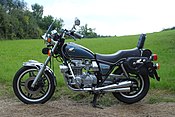This article needs additional citations for
verification. (May 2009) |
 Honda CB650K | |
| Manufacturer | Honda |
|---|---|
| Production | 1979–1985 |
| Predecessor | Honda CB550 |
| Successor | Honda CB650F |
| Class | Standard |
| Engine | 627 cc (38.3 cu in), air-cooled, 8-valve, SOHC, transverse four |
| Bore / stroke | 59.8 mm × 55.8 mm (2.35 in × 2.20 in) |
| Compression ratio | 9.0:1 |
| Power | 63 hp (47 kW) @ 9,000 rpm [1] |
| Transmission | 5- speed, manual, chain final drive |
| Suspension | Front: 35 mm
telescopic forks Rear: Twin Showa shocks with adjustable pre-load |
| Brakes | Front: Single-caliper
disc Rear: Drum |
| Tires | Front: 3.25 x 19 in Rear: 3.75 x 18 in |
| Weight | 467 lb (212 kg) [1] ( wet) |
The Honda CB650 is a 627 cc (38.3 cu in) standard motorcycle produced from 1979 to 1985. It featured a four-cylinder, SOHC, air-cooled, wet sump engine, with two valves per cylinder. The CB650 was a development of the CB550, itself derived from the even earlier CB500. The CB650 was the last of Honda's successful series of air-cooled SOHC fours that began in 1969 with the Honda CB750.
Model development
For cost-saving purposes, the CB650 was designed to be produced on the same production line as its CB550 predecessor, using the existing tooling. The CB650's cylinder block was a new design, but it shared the stud holes of the earlier bike, which may explain why the bike could not be a full 650cc machine. Likewise, the frame was almost identical to that of the CB550. Handlebar levers and instruments ( speedometer and tachometer) were also carried over from the earlier model. The CB650 produced a claimed 63 hp (47 kW) @ 9,000 rpm. [1]
In 1980, the CB650 was re-styled but there were no significant mechanical changes. After 1981, the CB650 had a modified cylinder head and new CV vacuum carburettors, and the bike was now available in either Standard or custom configurations. The latter had "cruiser" styling with a teardrop tank, chromed air-box, and smaller side covers. The 1980–1982 Standard model featured 4-into-2 exhaust pipes, a black plastic headlight nacelle, and wire-spoked wheels. The custom model featured 4-into-4 exhaust, Comstar wheels, a chrome headlight nacelle, and in 1981, dual disc front brakes and air-assisted forks.
A second generation model was produced from 1982 to 1985. In 1982, replacing the Custom, the new Nighthawk featured a re-designed tank and side covers, while the 1982 Standard model remained largely unchanged. In 1983, the SOHC engine was replaced by a new rubber-mounted DOHC engine featuring hydraulic valve-lash adjusters; and final drive was changed from chain to shaft-drive.
-
CB650 standard, two-up
-
CB650C Custom
See also
References

